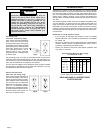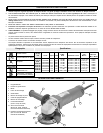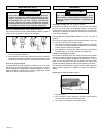
page 6
Ceramic
Aluminum
Zirconia Bi-Cut
Aluminum
Oxide
For fast cutting, gen-
eral purpose discs
for most metal jobs.
Best for cold-rolled
steel, stainless steel
or metals requiring
tough, fast cutting,
long lasting abra-
sives.
Lasts up to 3 times
longer than Aluminum
Oxide Discs. For
general metal work-
ing. Ideal for tough
jobs.
Unique grit pattern is
arranged in clusters
for faster stock re-
moval and cleaning.
Ideal for removing
paint from cars,
boats, etc. without
clogging.
Installing Backing Pad and Sanding Discs (Fig. 3)
Sanding (Fig. 4)
1. Use a clamp, vise or other practical means to hold your work, free-
ing both hands to control your tool. Firmly grasp body of tool and
side handle before starting and while tool is in operation. Allow
sanding disc to come to full speed before beginning to sand.
2. Hold sander/grinder at 5° to 15° angle (Fig. 4) to ensure proper
sanding pressure and control. Too great an angle will result in too
much pressure and could cause excessive wear to the disc and
workpiece. Too small an angle will reduce control.
3. Use long, sweeping, side to side strokes, advancing forward to
produce the desired finish.
Removing Welds or Hammer Marks
When removing welds or hammer marks, limit coarse sanding to the
immediate area. Use successively finer grits to smooth surface.
Cross Sanding
When finishing a surface that has been prepared by a coarse disc or
wheel, sand at right angles to the strokes made by the coarser disc.
Finishing marks left from previous sanding are easily seen and removed
for a uniform finish. Failure to cross sand when changing from a coarse
disc to a finishing disc may result in deep scratches and circular marks.
Finishing Metal
Constantly move across the surface. Work faster on curved surfaces
where contact areas are smaller and pressure is greater. Flat areas may
appear at the end of the stroke when pressure is too heavy. Ease up on
pressure at end of each stroke and when reversing strokes.
Troubleshooting
Deep scratches and circular marks can result from:
Using too coarse a grit
Using a partially glazed disc
Dirt or loose metal on the workpiece
Failure to sand across the grain when changing from coarse to
finishing discs
Failure to use closed coated discs to reduce the problem
of grains working loose and scratching the workpiece
Bluish discoloration of metal surface indicates:
Excessive heat caused by circular motion in a small area
Excessive pressure
Use of worn out or glazed discs
Fig. 3
Gear case
Spindle
Backing pad
Disc nut
Sanding disc
1. Unplug tool and place it upside down on a level surface. Remove
any accessories from spindle.
2. Slip backing pad onto spindle with flat side away from gear case.
3. Place sanding disc on backing pad and secure assembly to spindle
with disc nut.
4. To tighten, press the spindle lock button while turning disc nut clock-
wise with the spanner wrench provided.
5. To remove backing pad and sanding disc, unplug tool and reverse
procedure.
Fig. 4
For best result use
only this portion of disc
Hold at a 5° to 15° angle
Use backing pads, adapters, and other accessories that are:
correct size for tool and for sanding disc or grinding wheel.
rated at or above the RPM listed in the "WARNING" section on the
tool's nameplate.
the proper accessory for the job.
Sanding Disc and Grinding Wheel Material
Sanding discs and grinding wheels are made of various materials and
are designed for different jobs. Be sure that you choose the proper
sanding disc or grinding wheel for the job you plan to do.
Selecting Sanding Discs & Grit
Refer to the table below to select the correct type of sanding disc for
your job. Generally, use 24 or 36 grit for heavy stock removal; 50, 60, or
80 grit for medium stock removal and 120 grit for finishing. Always begin
with a coarse grit, using successively finer grits to obtain the desired
finish. See your MILWAUKEE Electric Tool Catalog for a complete list of
sanding discs.


















